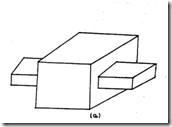KINEMATICS PAIRS
Pairing elements: the geometrical forms by which two members of a mechanism are joined together, so that the relative motion between these two is consistent are known as pairing elements and the pair so formed is called kinematic pair. Each individual link of a mechanism forms a pairing element.
Fig.1.05 Kinematic pair
Types of kinematic pairs:
(i) Based on nature of contact between elements:
(a) Lower pair. If the joint by which two members are connected has surface contact, the pair is known as lower pair. Eg. pin joints, shaft rotating in bush, slider in slider crank mechanism.
Fig.1.06 Lower pairs
(b) Higher pair. If the contact between the pairing elements takes place at a point or along a line, such as in a ball bearing or between two gear teeth in contact, it is known as a higher pair.
Fig.1.07 Higher pairs
(ii) Based on relative motion between pairing elements:
(a) Siding pair. Sliding pair is constituted by two elements so connected that one is constrained to have a sliding motion relative to the other. DOF = 1
(b) Turning pair (revolute pair). When connections of the two elements are such that only a constrained motion of rotation of one element with respect to the other is possible, the pair constitutes a turning pair. DOF = 1
(c) Cylindrical pair. If the relative motion between the pairing elements is the combination of turning and sliding, then it is called as cylindrical pair. DOF = 2
|
Fig.1.08 Sliding pair |
Fig.1.09 Turning pair |
Fig.1.10 Cylindrical pair
(d) Rolling pair. When the pairing elements have rolling contact, the pair formed is called rolling pair. Eg. Bearings, Belt and pulley. DOF = 1
|
Fig.1.11 (a) Ball bearing |
Fig.1.11(b) Belt and pulley |
(e) Spherical pair. A spherical pair will have surface contact and three degrees of freedom. Eg. Ball and socket joint. DOF = 3
(f) Helical pair or screw pair. When the nature of contact between the elements of a pair is such that one element can turn about the other by screw threads, it is known as screw pair. Eg. Nut and bolt. DOF = 1
|
Fig.1.12 Ball and socket joint |
Fig.1.13 Screw pair |
(iii) Based on the nature of mechanical constraint.
(a) Closed pair. Elements of pairs held together mechanically due to their geometry constitute a closed pair. They are also called form-closed or self-closed pair.
(b) Unclosed or force closed pair. Elements of pairs held together by the action of external forces constitute unclosed or force closed pair .Eg. Cam and follower.
|
Fig.1.14 Closed pair |
Fig. 1.15 Force closed pair (cam & follower) |













10 Responses to “KINEMATICS PAIRS and its classification”
Gebremichael
I like the notes
posted
Gebremichael
the notes must be brief!
admin
Thanks
Prabhu
Sir please explain classifications of pairs based on degree of freeedom
bhaves thakre
best info
Shaik iliyas basha
Good simple and logical explanation
Himanshu Prajapati
Nice explanation
safi
non sense
prabhu
what type of kinematic pair exists between human shoulders and arm based on nature of contact and nature of relative motion?
V.Sundareswaran
Kinematic pair exist between human shoulders and arm is a Lower Pair by nature of contact, i.e. Surface Contact, and is a Spherical Pair based on nature of relative motion, since it is a Ball and Socket Joint with rotation about all the three axes, i.e.a three degrees of freedom pair.